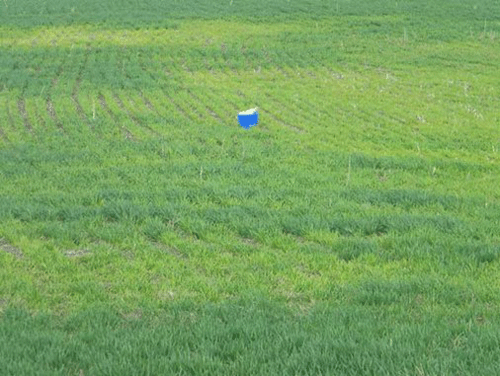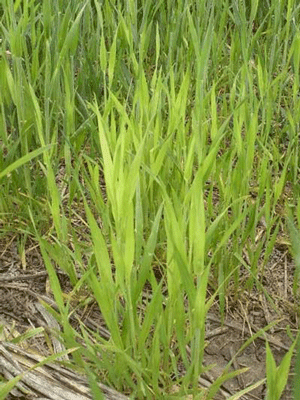In recent years, sulfur (S) deficiency in wheat has become more common in many areas of Kansas, particularly in no-till wheat. The likely reasons for this are a reduction in sulfur additions to the crop from atmospheric deposition (there is less S in the air now) and cooler soil temperatures as a result of no-till, which slows S mineralization in the soil. Some crops in the rotation, such as soybean, can also take up significant amounts of S, resulting in an S deficit for the following wheat crop. Most of the crop's S needs will occur after spring green-up when the crop goes through stem elongation.
Historically, S deficiency was most common in high-yielding crops grown on irrigated, sandy soils that are low in organic matter and subject to leaching. However, due to the reasons discussed above, an increasing number of finer-textured soils have shown S deficiency in recent years.
Identification of S deficiency
The photos below are good representations of S deficiency in wheat. Generally, S-deficient wheat is yellow and stunted and is observed in patches in the field, especially in areas with previous soil erosion or movement (Figure 1). The patchy S-deficient areas of the field are often found on hilltops or side slopes where erosion has occurred, and soil organic matter is reduced or where leaching is more pronounced. Wheat in areas where topsoil was removed or significant cuts were made (i.e. terraced or leveled fields) also commonly shows symptoms.

Figure 1. Patches of sulfur deficiency in a wheat field. Photo by Dave Mengel, K-State Research and Extension.
Sulfur deficiency in growing crops is often mistaken for nitrogen (N) deficiency. However, unlike N deficiency, where older leaves show firing and yellowing, with S deficiency, the pale-yellow symptoms often appear first on the younger or uppermost leaves. Wheat plants with S deficiency eventually become uniformly chlorotic (yellow leaf tissue; Figure 2).

Figure 2. Close-up of sulfur deficiency in wheat. The wheat is exhibiting yellowing (chlorosis), a sign of insufficient sulfur. Photo by Dorivar Ruiz Diaz, K-State Research and Extension.
Sulfur deficiencies in wheat have been showing up early in the spring, shortly after green-up, before organic S is mineralized from soil organic matter and before wheat roots can grow into the subsoil to utilize any available S (sulfate) accumulations. Deficiencies of S are often difficult to identify because the chlorosis is not always obvious. Crops lacking S also may be stunted, thin-stemmed, and spindly. In the case of wheat and other cereal grains, maturity is delayed. Winter annual weed competition is also enhanced due to the slower growth and lack of good tillering.
Many fields in north central and northeast Kansas have an established history of S deficiency for wheat. In this situation, rather than waiting for symptoms to appear in the spring, farmers may want to consider a winter top-dress application of S as a preventive measure.
Forms of sulfur in soil
The majority of S in soils is present in organic forms in surface soils and as sulfate (SO42-), an inorganic form. Sulfate is relatively soluble and tends to leach down into the subsoil. Many of our Kansas soils will accumulate sulfate in the B horizon (subsoil) in two forms. Clay surfaces and coatings will retain some sulfate, and sulfate will also be present in the subsoil of many Kansas soils as gypsum (calcium sulfate).
Testing soil for sulfur
There is a soil test for available sulfate-S in the soil profile. Soil texture, soil organic matter, the crop to be grown, and the expected yield level should all be considered when interpreting this soil test. Accurate estimates of S needs cannot be made from a surface sample alone. Since sulfate is mobile, sampling to a 24-inch depth is important. However, due to the relatively high demand for S during the rapid vegetative growth phase of wheat and relatively shallow rooting by the wheat crop at this time, the S measured in the deeper subsoil levels by the test may not be available to wheat in the early spring, especially where soils are cold. Now is a good time to collect soil samples and assess S levels as we plan for topdressing.
Testing leaves for sulfur
Leaf tissue tests can be useful, particularly when determining the exact cause of yellow wheat. A representative sample can be made by collecting the newest mature leaves from 30+ plants throughout the area where deficiency symptoms are observed (“bad” areas). A similar sample from a “good” area (no deficiency symptoms) should also be collected. This will allow direct comparisons between “good” and “bad” areas.
Choosing a fertilizer material
There are many S-containing fertilizer materials. Several dry materials are available that can be blended with dry phosphorus or nitrogen fertilizers for winter/spring topdressing. However, some of these products are best used in pre-plant applications.
Dry fertilizers
- Elemental S (typically 90-95 percent S) is a dry material marketed by several manufacturers. Before it becomes available for plant uptake, elemental S must first be oxidized by soil microorganisms to sulfate. This can be a slow process, as a result, elemental S is not well suited for spring topdress applications to S-deficient wheat due to the time required for oxidation to sulfate, but it could be a good source for future crops in the rotation. This oxidation process also generates acidity and soil pH should be monitored, especially when broadcast over minimum-tillage fields.
- Ammonium sulfate, AMS (21-0-0-24S), is a dry material that is highly water-soluble and is a good source of both N and S. However, it has a high acid-forming potential and soil pH should be monitored. Ammonium sulfate is a good source to consider for either pre-plant or topdressing.
- Gypsum (analysis varies) is calcium sulfate and is commonly available in a hydrated form containing 18.6 percent S. This material is commonly available in a granulated form that can be blended with other materials. Since it is a sulfate source, it would be immediately available and is another good source for spring topdressing. However, gypsum is not as water soluble as many fertilizer materials such as ammonium sulfate.
- New N-P-S products such as Microessentials, 40-rock, MAP+MST, and others that are typically ammonium phosphate materials formulated with S, and in some cases, micronutrients such as zinc. In most of these products, the S is present as a combination of elemental S and sulfate.
Liquid fertilizers
- Ammonium thiosulfate, ATS (12-0-0-26S), is the most popular S-containing product used in the fluid fertilizer industry as it is compatible with N solutions and other complete liquid products.
- Potassium thiosulfate, KTS (0-0-25-17S), is a clear liquid product that can be mixed with other liquid fertilizers.
Topdressing with thiosulfate and UAN can be done early, before Feekes 5 growth stage (green up), and at temperatures below 70 degrees F. Be aware that some leaf burn may be expected with some of these liquid fertilizers. These products would be good sources for pre-plant application as well.
Supplemental resources
- Sulfur in Kansas (MF 2264), http://www.ksre.ksu.edu/bookstore/pubs/MF2264.pdf
- For estimations of required application rates of S - Soil Test Interpretation and Fertilizer Recommendations, (MF2586) http://www.ksre.ksu.edu/bookstore/pubs/mf2586.pdf
Dorivar Ruiz Diaz, Soil Fertility and Nutrient Management Specialist
ruizdiaz@ksu.edu
Romulo Lollato, Wheat and Forages Specialist
lollato@ksu.edu
Bryan Rutter, Soil Testing Lab Manager
rutter@ksu.edu